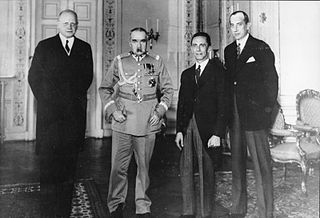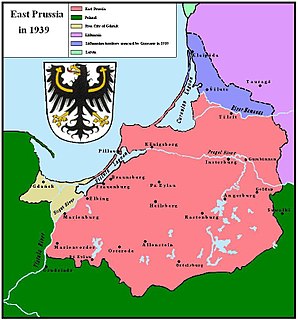Related Research Articles

The Molotov–Ribbentrop Pact was a non-aggression pact between Nazi Germany and the Soviet Union that enabled those two powers to partition Poland between them. The pact was signed in Moscow on 23 August 1939 by German Foreign Minister Joachim von Ribbentrop and Soviet Foreign Minister Vyacheslav Molotov and was officially known as the Treaty of Non-Aggression between Germany and the Union of Soviet Socialist Republics. Unofficially, it has also been referred to as the Hitler–Stalin Pact, Nazi–Soviet Pact or Nazi–Soviet Alliance.

The Munich Agreement was an agreement concluded at Munich on 30 September 1938, by Germany, the United Kingdom, the French Third Republic, and the Kingdom of Italy. It provided "cession to Germany of the Sudeten German territory" of Czechoslovakia, despite the existence of a 1924 alliance agreement and 1925 military pact between France and the Czechoslovak Republic, for which it is also known as the Munich Betrayal. Most of Europe celebrated the Munich agreement, which was presented as a way to prevent a major war on the continent. The four powers agreed to the annexation of the Czechoslovak borderland areas named the Sudetenland, where more than three million people, mainly ethnic Germans, lived. Adolf Hitler announced it was his last territorial claim in Europe.

The Pact of Steel, known formally as the Pact of Friendship and Alliance between Germany and Italy, was a military and political alliance between Italy and Germany.

The Locarno Treaties were seven agreements negotiated at Locarno, Switzerland, during 5 to 16 October 1925 and formally signed in London on 1 December, in which the First World War Western European Allied powers and the new states of Central and Eastern Europe sought to secure the post-war territorial settlement, in return for normalising relations with the defeated German Reich. It also stated that Germany would never go to war with the other countries. Locarno divided borders in Europe into two categories: western, which were guaranteed by the Locarno treaties, and eastern borders of Germany with Poland, which were open for revision.

The Anti-Comintern Pact, officially the Agreement against the Communist International was an anti-Communist pact concluded between Nazi Germany and the Empire of Japan on 25 November 1936 and was directed against the Communist International (Comintern). It was signed by German ambassador-at-large Joachim von Ribbentrop and Japanese ambassador to Germany Kintomo Mushanokōji. Italy joined in 1937, but it was legally recognised as an original signatory by the terms of her entry. Spain and Hungary joined in 1939. Other countries joined during World War II.

The invasion of Poland, also known as the September campaign, 1939 defensive war and Poland campaign, was an attack on the Republic of Poland by Nazi Germany and the Soviet Union which marked the beginning of World War II. The German invasion began on 1 September 1939, one week after the signing of the Molotov–Ribbentrop Pact between Germany and the Soviet Union, and one day after the Supreme Soviet of the Soviet Union had approved the pact. The Soviets invaded Poland on 17 September. The campaign ended on 6 October with Germany and the Soviet Union dividing and annexing the whole of Poland under the terms of the German–Soviet Frontier Treaty.

The Little Entente was an alliance formed in 1920 and 1921 by Czechoslovakia, Romania and the Kingdom of Serbs, Croats and Slovenes with the purpose of common defense against Hungarian revanchism and the prospect of a Habsburg restoration. France supported the alliance by signing treaties with each member country. The rapid growth of German power caused its collapse in 1938, and it never went into wartime operation.

The Treaty of Rapallo was a treaty between the Kingdom of Italy and the Kingdom of Serbs, Croats and Slovenes that was signed to solve the dispute over some territories in the former Austrian Littoral, which was in the northern Adriatic, as well as in Dalmatia.

The German occupation of Czechoslovakia (1938–1945) began with the German annexation of the Sudetenland in 1938, continued with the March 1939 invasion of the Czech lands and creation of the Protectorate of Bohemia and Moravia, and by the end of 1944 extended to all parts of the former Czechoslovakia.

Western betrayal is the view that the United Kingdom, France, and sometimes the United States failed to meet their legal, diplomatic, military, and moral obligations with respect to the Czechoslovak and Polish states during the prelude to and aftermath of World War II. It also sometimes refers to the treatment of other Central and Eastern European states at the time.

The German–Polish declaration of non-aggression, also known as the German–Polish non-aggression pact, was a non-aggression agreement between Nazi Germany and the Second Polish Republic that was signed on 26 January 1934 in Berlin. Both countries pledged to resolve their problems by bilateral negotiations and to forgo armed conflict for a period of 10 years. The agreement effectively normalised relations between Poland and Germany, which had been strained by border disputes arising from the territorial settlement in the Treaty of Versailles. Germany effectively recognised Poland's borders and moved to end an economically-damaging customs war between the two countries that had taken place over the previous decade.
The Polish–Romanian alliance was a series of treaties signed in the interwar period by the Second Polish Republic and the Kingdom of Romania. The first of them was signed in 1921 and, together, the treaties formed a basis for good foreign relations between the two countries that lasted until World War II began in 1939.

The remilitarization of the Rhineland began on 7 March 1936, when German military forces entered the Rhineland, which directly contravened the Treaty of Versailles and the Locarno Treaties. Neither France nor Britain was prepared for a military response, so they did not act. After 1939 commentators often said that a strong military move in 1936 might have ruined Hitler's expansionist plans. However, recent historiography agrees that both public and elite opinion in Britain and France strongly opposed a military intervention, and neither had an army prepared to move in.

The Italian invasion of Albania was a brief military campaign by the Kingdom of Italy against the Albanian Kingdom. The conflict was a result of the imperialist policies of Italian dictator Benito Mussolini. Albania was rapidly overrun, its ruler King Zog I forced into exile in neighbouring Greece, and the country made part of the Italian Empire as a protectorate in personal union with the Italian Crown.
The Franco-Soviet Treaty of Mutual Assistance was a bilateral treaty between France and the Soviet Union with the aim of enveloping Nazi Germany in 1935 to reduce the threat from Central Europe. It was pursued by Maxim Litvinov, the Soviet foreign minister, and Louis Barthou, the French foreign minister, who was assassinated in October 1934, before negotiations had been finished. His successor, Pierre Laval, was sceptical of the desirability and of the value of an alliance with the Soviet Union. However, after the declaration of German rearmament in March 1935, the French government forced the reluctant foreign minister to complete the arrangements with Moscow that Barthou had begun.

The 1939 German ultimatum to Lithuania was an oral ultimatum which Joachim von Ribbentrop, Foreign Minister of Nazi Germany, presented to Juozas Urbšys, Foreign Minister of Lithuania on 20 March 1939. The Germans demanded that Lithuania give up the Klaipėda Region which had been detached from Germany after World War I, or the Wehrmacht would invade Lithuania and the Lithuanian capital Kaunas would be bombed. The Lithuanians had been expecting the demand after years of rising tension between Lithuania and Germany, increasing pro-Nazi propaganda in the region, and continued German expansion. It was issued just five days after the Nazi occupation of Czechoslovakia. The 1924 Klaipėda Convention had guaranteed the protection of the status quo in the region, but the four signatories to that convention did not offer any material assistance. The United Kingdom and France followed a policy of appeasement, while Italy and Japan openly supported Germany, and Lithuania accepted the ultimatum on 23 March 1939. It proved to be the last territorial acquisition for Germany before World War II, producing a major downturn in Lithuania's economy and escalating pre-war tensions for Europe as a whole.
The timeline of the Molotov–Ribbentrop Pact is a chronology of events, including Molotov–Ribbentrop Pact negotiations, leading up to, culminating in, and resulting from the Molotov–Ribbentrop Pact. The Treaty of Non-aggression between Nazi Germany and the Soviet Union was signed in the early hours of August 24, 1939, but was dated August 23.

The background of the occupation of the Baltic states covers the period before the first Soviet occupation on 14 June 1940, stretching from independence in 1918 to the Soviet ultimatums in 1939–1940. Lithuania, Latvia, and Estonia gained independence in the aftermath of the Russian revolutions of 1917 and the German occupation which in the Baltic countries lasted until the end of World War I in November 1918. All three countries signed non-aggression treaties with the Soviet Union in the 1920s and 1930s. Despite the treaties, in the aftermath of the 1939 German–Soviet pact, Estonia, Latvia and Lithuania were occupied, and thereafter forcibly incorporated into the Soviet Union, in 1940.
International relations (1919–1939) covers the main interactions shaping world history in this era, with emphasis on diplomacy and economic relations. The coverage here follows the diplomatic history of World War I and precedes the diplomatic history of World War II. The important stages of interwar diplomacy and international relations included resolutions of wartime issues, such as reparations owed by Germany and boundaries; American involvement in European finances and disarmament projects; the expectations and failures of the League of Nations; the relationships of the new countries to the old; the distrustful relations of the Soviet Union to the capitalist world; peace and disarmament efforts; responses to the Great Depression starting in 1929; the collapse of world trade; the collapse of democratic regimes one by one; the growth of economic autarky; Japanese aggressiveness toward China; Fascist diplomacy, including the aggressive moves by Mussolini's Italy and Hitler's Germany; the Spanish Civil War; the appeasement of Germany's expansionist moves toward the Rhineland, Austria, and Czechoslovakia, and the last, desperate stages of rearmament as another world war increasingly loomed.
References
- ↑ Umowa polityczna francusko–polska, podpisana w Paryżu 19 lutego 1921 r. (Dz.U. 1922 nr 63 poz. 563), registration July 2, 1923: France and Poland - Political Agreement, signed at Paris, February 19, 1921 (1923 LNTSer 87; 18 LNTS 11)
- ↑ Accord militaire franco–polonais Paris, 19 février 1921: Documents Diplomatiques Francais: 1921 - Tome I (16 Janvier - 30 Juin), Secret Milit Convention between France and Poland
- 1 2 Piotr Stefan Wandycz (1 January 1962). France and Her Eastern Allies, 1919–1925: French–Czechoslovak–Polish Relations from the Paris Peace Conference to Locarno. U of Minnesota Press. pp. 217–. ISBN 978-0-8166-5886-2.
- ↑ Dz.U. 1923 nr 106 poz. 833
- ↑ Traktat Gwarancyjny pomiędzy Polską a Francją, podpisany w Londynie 1 grudnia 1925 r. (Dz.U. 1926 nr 114 poz. 660), registration September 14, 1926: France and Poland - Treaty of Mutual Guarantee, done at Locarno, October 16, 1925 (1926 LNTSer 250; 54 LNTS 353)
- ↑ This paragraph is based on a review of Zandycz book by Detlef Brandes, from Slavic Review, Fall 1990 issue
- ↑ Protocole Franco–Polonais 1939 Gamelin-Kasprzycki : Contre-témoignage sur une catastrophe, Protokół końcowy francusko–polskich rozmów sztabowych 15–17 maja 1939
- ↑ Anita J. Prazmowska (12 February 2004). Britain, Poland and the Eastern Front, 1939. Cambridge University Press. pp. 103–. ISBN 978-0-521-52938-9.
- ↑ Nicole Jordan (22 August 2002). The Popular Front and Central Europe: The Dilemmas of French Impotence 1918–1940. Cambridge University Press. pp. 294–. ISBN 978-0-521-52242-7.
- ↑ pages 279-280[ full citation needed ]